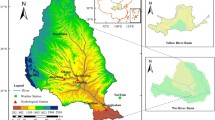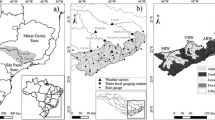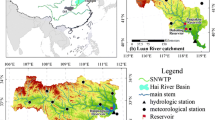Abstract
The East River in South China plays a key role in the socio-economic development in the region and surrounding areas. Adequate understanding of the hydrologic response to land use change is crucial to develop sustainable water resources management strategies in the region. The present study makes an attempt to evaluate the possible impacts of land use change on hydrologic response using a numerical model and corresponding available vegetation datasets. The variable infiltration capacity model is applied to simulate runoff responses to several land use scenarios within the basin (e.g., afforestation, deforestation, and reduction in farmland area) for the period 1952–2000. The results indicate that annual runoff is reduced by 3.5 % (32.3 mm) when 25 % of the current grassland area (including grasslands and wooded grasslands, with 46.8 % of total vegetation cover) is converted to forestland. Afforestation results in reduction in the monthly flow volume, peak flow, and low flow, but with significantly greater reduction in low flow for the basin. The simulated annual runoff increases by about 1.4 % (12.6 mm) in the deforestation scenario by changing forestland (including deciduous broadleaf, evergreen needleleaf, and broadleaf, with 15.6 % of total vegetation cover) to grassland area. Increase in seasonal runoff occurs mainly in autumn for converting cropland to bare soil.








Similar content being viewed by others
References
Abdulla FA, Lettenmaier DP, Wood EF, Smith JA (1996) Application of a macroscale hydrological model to estimate the water balance of the Arkansas-Red river basin. J Geophys Res 101(D3):7449–7459
Chen XH, Wang ZL (2010) Land use change and its impact on water resources in the East River basin, South China. J Beijing Normal Univ 46(3):311–316 (in Chinese)
Chen J, Wu YP (2012) Advancing representation of hydrologic processes in the soil and water assessment tool (SWAT) through integration of the TOPographic MODEL (TOPMODEL) features. J Hydrol 420:319–328
Feng S, Hu Q, Qian WH (2004) Quality control of daily meteorological data in China, 1951–2000: a new dataset. Int J Climatol 24:853–870
Fok L, Thoe W, Peart MR, Koenig A, Lee JHW (2009) Nitrogen source apportionment of the East River (Dongjiang), China. Asian Geographer 26:95–110
Heathcote IW (2009) Integrated watershed management: principles and practice, 2nd edn. Wiley, Hoboken
Huang QH, Cai YL (2007) Simulation of land use change using GIS-based stochastic model: the case study of Shiqian County, Southwestern China. Stoch Environ Res Risk Assess 21:419–426
Huang MB, Zhang L, Gallichand J (2003) Runoff responses to afforestation in a watershed of the Loess Plateau, China. Hydrol Process 17:2599–2609
Jiang T, Chen YQ, Xu CY, Chen XH, Chen X, Singh VP (2007) Comparison of hydrological impacts of climate change simulated by six hydrological models in the Dongjiang Basin, South China. J Hydrol 336:316–333
Lettenmaier DP, Wood EF, Burges SJ (1994) A simple hydrologically based model of land surface water and energy fluxes for general circulation models. J Geophys Res 99(D7):14415–14428
Liang G, Chen Q, Deng H (1993) Resources, environment and economic development of Dongjiang Basin in Guangdong. China Ocean Press, Beijing (in Chinese)
Lu XX (2004) Vulnerability of water discharge of large Chinese rivers to environmental changes: an overview. Reg Environ Chang 4:182–191
Mishra AK, Desai VR (2005) Drought forecasting using stochastic models. Stoch Environ Res Risk Assess 19:326–339
Mishra AK, Özger M, Singh VP (2011) Wet and dry spell analysis of global climate model-generated precipitation using power laws and wavelet transforms. Stoch Environ Res Risk Assess 25:517–535
Moriasi DN, Arnold JG, Van Liew MW, Bingner RL, Harmel RD, Veith TL (2007) Model evaluation guidelines for systematic quantification of accuracy in watershed simulations. Trans ASABE 50(3):885–990
Nijssen B, Lettenmaier DP, Liang X, Wetzel SW, Wood EF (1997) Runoff simulation for continental-scale river basins. Water Resour Res 33(4):711–724
Nijssen B, Schnur R, Lettenmaier DP (2001a) Global retrospective estimation of soil moisture using the VIC land surface model. J Clim 14:1790–1808
Nijssen B, O’Donnell GM, Lettenmaier DP, Lohmann D, Wood EF (2001b) Predicting the discharge of global rivers. J Clim 14:3307–3323
Niu J, Chen J (2008) Application of VIC and routing scheme to Pearl River basin in South China. Adv Water Resour Hydraul Eng I:72–76. doi:10.1007/978-3-540-89465-0_14
Niu J, Chen J (2010) Terrestrial hydrological features of the Pearl River basin in South China. J Hydro-Environ Res 4:279–288. doi:10.1016/j.jher.2010.04.016
Pearl River Hydraulic Research Institute (2007) Drought monitor and assessment reports for the pearl river basin using remote sensing. Pearl River Hydraulic Research Institute: Guangzhou (in Chinese)
Pearl River Water Resource Commission (2005) Pearl River flood prevention handbook. Pearl River Water Resource Commission: Guangzhou (in Chinese)
Ren FP, Jiang Y, Xiong X, Dong MY, Wang B (2011) Characteristics of the spatial-temporal differences of land use changes in the Dongjiang River basin from 1990–2009. Res Sci 33(1):143–152 (in Chinese)
Sahin V, Hall MJ (1996) The effects of afforestation and deforestation on water yields. J Hydrol 178:293–309
Sharda VN, Samraj P, Samra JS, Lakshmanan V (1998) Hydrological behavior of first generation coppiced bluegum plantations in the Niligiri sub-watersheds. J Hydrol 211:50–60
Statistics Bureau of Guangdong Province (SBGP) (1991) Statistical Yearbook of Guangdong. China Statistic Press, Beijing (in Chinese)
Statistics Bureau of Guangdong Province (SBGP) (2001) Statistical yearbook of Guangdong. China Statistic Press, Beijing (in Chinese)
Statistics Bureau of Jiangxi Province (SBJP) (1991) Statistical yearbook of Jiangxi. China Statistic Press, Beijing (in Chinese)
Statistics Bureau of Jiangxi Province (SBJP) (2001) Statistical yearbook of Jiangxi. China Statistic Press, Beijing (in Chinese)
Wang SF, Kang SZ, Zhang L, Li FS (2008) Modelling hydrological response to different land-use and climate change scenarios in the Zamu River basin of northwest China. Hydrol Process 22:2502–2510
Wu YP, Chen J (2012) An operation-based scheme for a multiyear and multipurpose reservoir to enhance macro-scale hydrologic models. J Hydrometeor 12:1–14
Xu YP, Booij MJ, Tong YB (2010) Uncertainty analysis in statistical modeling of extreme hydrological events. Stoch Environ Res Risk Assess 24:567–578
Zhang Q, Xu CY, Yu ZG, Liu CL, Chen YQ (2009) Multifractal analysis of streamflow records of the East River basin (Pearl River), China. Physica A 15:927–934
Zhang Q, Chen YQ, Jiang T, Chen XH, Liu ZF (2011) Human-induced regulation of river channels and implications for hydrological alterations in the Pearl River Delta, China. Stoch Environ Res Risk Assess 25:1001–1011
Zhao RJ (1984) Water hydrological modeling—Xinanjiang model and Shanbei model, China. Water Resources and Hydropower Publishing House, Beijing (in Chinese)
Acknowledgments
This research was supported by the Hong Kong RGC GRF project (HKU 710910E) and PPR project (HKU 7022-PPR-2). The first author is grateful to Dr. Ji Chen for providing financial support to attend the 8th International Conference on Hydro-Science and Engineering in Nagoya, Japan in 2008, to present some early results of this work and also for some discussions immediately after that. The authors thank the anonymous reviewer for his/her valuable comments and suggestions on the paper.
Author information
Authors and Affiliations
Corresponding author
Rights and permissions
About this article
Cite this article
Niu, J., Sivakumar, B. Study of runoff response to land use change in the East River basin in South China. Stoch Environ Res Risk Assess 28, 857–865 (2014). https://doi.org/10.1007/s00477-013-0690-5
Published:
Issue Date:
DOI: https://doi.org/10.1007/s00477-013-0690-5




